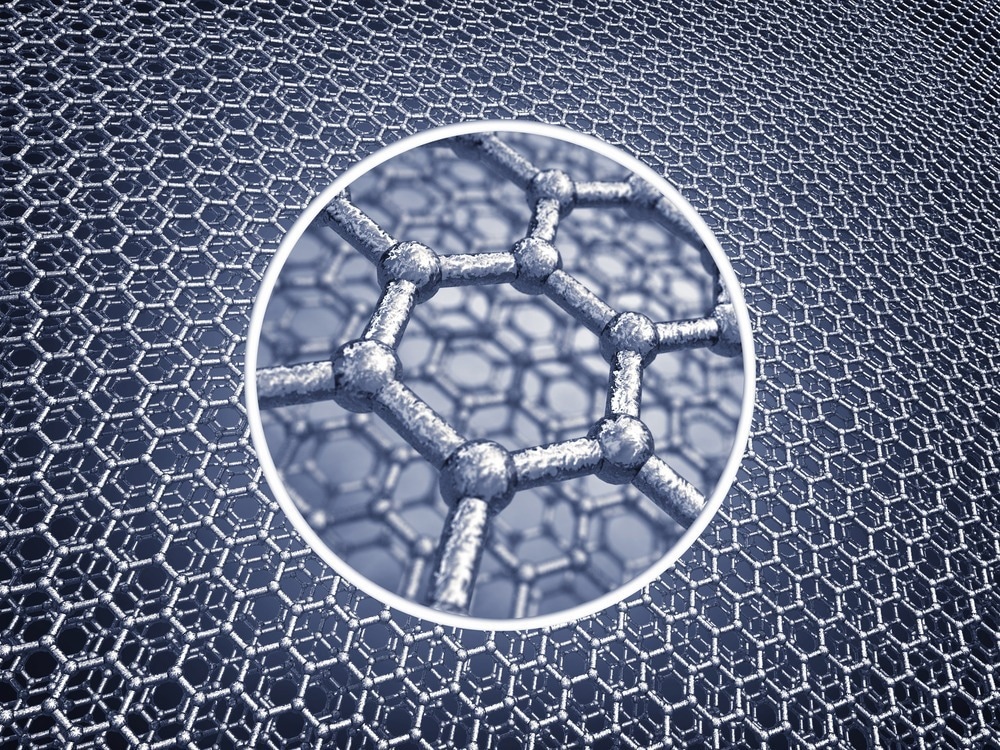Counterfeit graphene materials can pose a significant threat to the quality, reputation, financial stability, and advancement of the graphene industry.

Image Credit: nobeastsofierce/Shutterstock.com
It is important to take steps to prevent the spread of counterfeit graphene products and to ensure the use of high-quality graphene in all applications. Thermogravimetric analysis (TGA) is one of the most promising techniques for detecting low-cost carbon additives in advanced materials.
Numerous innovations are based on the unique properties of graphene. Graphene is a monolayer of carbon atoms arranged in a planar hexagonal pattern. Since its discovery in 2004, the two-dimensional material is considered revolutionary due to its extraordinary mechanical strength, excellent chemical stability, high thermal and electrical conductivity, optical transmittance, and high specific surface area.
All these fascinating properties are greatly affected by the quality of the graphene sheets. The rapidly expanding graphene manufacturing can lead to inferior product quality or the production of counterfeit graphene.
The Impact of Counterfeit Graphene
Counterfeit graphene refers to materials that are marketed as graphene but do not possess the unique properties and characteristics of pure graphene. These materials are often made from low-quality carbon sources such as graphite, carbon black, or other carbon-based materials that are not single-layer graphene.
Additionally, different production methods can produce graphene with different thicknesses (number of monolayers), varying structural defects, and impurities. Fundamental considerations dictate that a maximum of ten stacked graphene layers can exhibit the desired material properties at room temperature. Producing and sourcing good quality graphene is critical for the continuously growing graphene market.
Avoiding and identifying counterfeit graphene is an important problem. It can ensure enhanced and consistent quality control of graphene products and applications and prevent financial losses for businesses and consumers.
Basics of the TGA Method
Counterfeit graphene can be detected using a variety of techniques, including TGA, Raman spectroscopy, and atomic force microscopy.
TGA is a technique used to measure a sample's weight change as a function of temperature or time under controlled conditions. TGA is commonly used in materials science and engineering to determine the thermal stability of materials and to quantify the weight loss that occurs due to thermal degradation or decomposition.
The TGA apparatus consists of a balance and a furnace, which is capable of heating the sample at a controlled rate. The sample is placed in the furnace, and its weight is monitored as it is heated. The weight changes that occur as the sample is heated can provide information about its thermal stability, decomposition pathways, and degradation products.
TGA is a versatile and widely used analytical technique, and it can provide information about a wide range of materials, including polymers, ceramics, composites, and fuels.
Identifying Counterfeit Graphene
In the case of graphene, TGA can be used to identify counterfeit or low-quality graphene materials by measuring the weight loss of the material as it is heated. The technique can distinguish between high-quality graphene and counterfeit graphene by comparing the weight loss profile of the sample to a known reference sample of pure graphene. If the weight loss profile of the sample deviates significantly from the reference sample, it may indicate the presence of counterfeit or low-quality carbon present.
Carbon Materials Benchmarking Using TGA
Recently, a research group from the School of Chemical Engineering and Advanced Materials at the University of Adelaide in Australia, led by Prof. Dusan Losic, demonstrated that TGA could provide qualitative and quantitative analysis of graphene materials and differentiate between high-quality graphene and counterfeit graphene-like materials.
Initially, the Australian scientists established baseline TGA properties of various graphene-derived materials, such as multi-layer graphene, graphene oxide, reduced graphene oxide, and graphite (representing the essential impurities in graphene).
The baseline data captured the differences in the thermal decomposition behavior of the studied materials. The thermal stability (the temperature at which the material decomposition starts) of the materials was correlated to their intrinsic chemical and physical properties. The data was then used as a benchmark when characterizing graphene samples.
Evaluation of Counterfeit Carbon in Graphene Materials
Further analysis of pristine high-quality graphene revealed TGA characteristics (peak positions and temperature values) that were distinctive from most baseline materials. In particular, the TGA data revealed a very high temperature of maximum mass loss rate (>800 °C) for graphite, enabling reliable detection of graphite impurities in graphene.
Graphite is a common counterfeit material that is often mislabelled as graphene. This can occur either due to insufficient exfoliation during the production process or due to intentional mislabeling. The only exception was the TGA data of carbon black exhibiting peaks at similar positions as pristine graphene, indicating a potential challenge for detecting carbon black impurities in graphene.
The results of this study offer significant insights into the impact of particle size on these materials and will aid in establishing TGA as a cost-effective and straightforward tool for graphene characterizing. This rapid method can be employed to detect counterfeit graphene containing high levels of graphitic particles in industrially produced graphene materials.
References and Further Reading
Losic, D., et al. (2021) Accounting Carbonaceous Counterfeits in Graphene Materials Using the Thermogravimetric Analysis (TGA) Approach. Analytical Chemistry 93(34), pp. 11859-11867. doi.org/10.1021/acs.analchem.1c02662
Khan, M. (2021) Using Thermogravimetric Analysis to Determine 'Fake' Graphene. [Online] AZoNano. Available at: https://www.azonano.com/article.aspx?ArticleID=5783
Critchley, L. (2019) An independent view on the graphene war. [Online] Chemistry World. Available at: https://www.chemistryworld.com/opinion/an-independent-view-on-the-graphene-war/3010288.article
Bøggild, P. (2018) The war on fake graphene. Nature 562, pp. 502-503. doi.org/10.1038/d41586-018-06939-4
Oney, F. (2018) Poor quality (or fake) graphene could be hindering your research. [Online] The American Ceramic Society. Available at: https://ceramics.org/ceramic-tech-today/raw-materials-supply/poor-quality-or-fake-graphene-could-be-hindering-your-research
Disclaimer: The views expressed here are those of the author expressed in their private capacity and do not necessarily represent the views of AZoM.com Limited T/A AZoNetwork the owner and operator of this website. This disclaimer forms part of the Terms and conditions of use of this website.